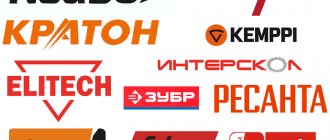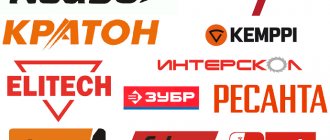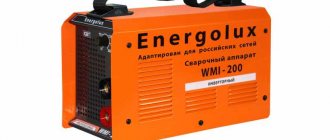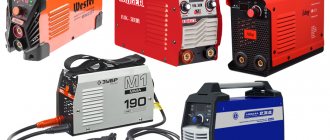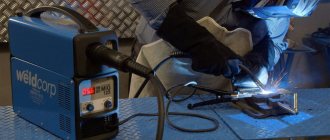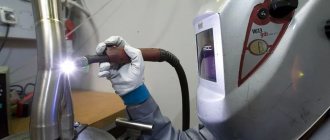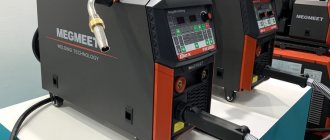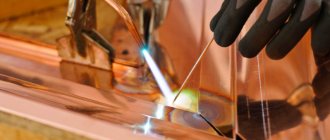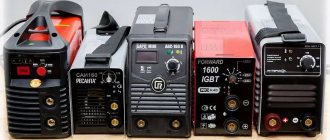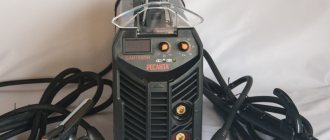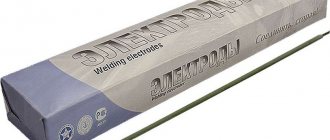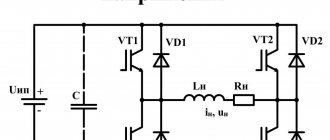Choosing a high-quality and inexpensive unit is not as easy as it might seem. The market is overflowing with offers, and not all types of welding machines are equivalent to each other. Each has features, advantages and disadvantages. You shouldn’t give in to the persuasion of sales managers - it’s better to understand the structure and parameters of welders yourself, then it will be easier to make a choice.
There are 4 types of devices:
- Transformers are inexpensive and simple in design, but heavy and bulky devices. Welding is performed using alternating current. Due to this, only ferrous metals (cast iron, steel) can be welded.
- Rectifiers - also based on a transformer, but welding is carried out using direct current. Due to this, the strength and quality of the connection is higher, and the consumption of materials is lower. Usually used in industry.
- Inverters are compact and lightweight (from 3 kg) devices. The most convenient to use and recommended for beginner welders. They are characterized by a stable arc and can be used for welding non-ferrous metals and thin sheet metal.
- Semi-automatic machines are productive devices that are optimal for long-term operation. Capable of working with all types of metals. Widely used in car repair shops.
Semi-automatic
Semi-automatic welding is the use of wire as an electrode and filler metal.
The latter is automatically supplied to the electric arc zone. Semi-automatic machines are made according to the principle:
- transformer;
- rectifier:
- inverter
The main difference is the wire feed unit into the combustion zone and equipment with a gaseous environment.
Fig.5 General list of components used for semi-automatic welding
For the semi-automatic machine, copper-plated calibrated steel wire is used. The coating ensures good electrical contact and glide through the mouthpiece of the holder.
Current is supplied to a conductive mouthpiece. The electric arc melts the wire. The required and constant wire length is ensured by the feed mechanism. Gas is supplied through the welding torch. The purpose of the gas component is to form a protective cloud that cuts off the influence of air oxygen.
The semi-automatic machine can perform work without a protective gas environment. For this, a special wire with flux in powder form is used. The design is a sheath made of the actual welding wire, inside of which there is protective powder.
Advantages
- high weld quality indicators;
- processing of materials that are difficult to weld;
- ability to work with thin sheet metal (for example, automotive sheet);
- almost complete absence of waste, low spattering;
- it is allowed to carry out work without preliminary cutting of the edges of the processed semi-finished products;
- efficiency - less metal (wire) consumption, use of gas instead of expensive flux (electrode);
- increasing labor productivity;
- simplification of the welding procedure - there is no effect of the wire freezing to the part at the end of the process.
Flaws
- availability of additional equipment - wire feeder, gas equipment;
- complications during transportation due to the bulkiness of the entire set;
- the need to protect the gas torch from the wind when working in open areas;
- increase in equipment costs.
In general, welding and welding equipment in a semi-automatic process are almost indispensable when working with thin-walled products (automotive industry). Or when processing chemically active (aluminum, titanium) or difficult-to-weld (cast iron, high-alloy steels, etc.) materials.
Advantages of welding inverters
The use of new generation welding equipment makes it possible to improve the quality of welding of metal structures and significantly simplifies the work of both professional welders and craftsmen working at home.
Compared to classic welding equipment, inverter-type semi-automatic welding machines have many advantages. The main ones:
- Compact dimensions and low weight greatly simplify the transportation and storage of welding and make inverters convenient to use.
- It is possible to use direct and alternating current electrodes, which allows you to obtain high-quality seams when working with products made of cast iron, aluminum, stainless steel, and heat-resistant steel grades.
- A large range of control of the input current allows the use of non-consumable electrodes for arc welding under gas protection.
- Availability of additional functions. “Hot start” ensures the supply of current of the optimal value necessary to ignite the electrode. "Anti-Sticking" reduces the current supply to a minimum when a short circuit occurs. “Arc Force” increases the current at the moment of drop separation, preventing sticking.
When choosing welding for home or work in a workshop, you need to focus on the time of continuous operation of the equipment. Professional welding inverters can work up to 8 hours without a break. After half an hour of operation, household-grade equipment will require 30 to 60 minutes to cool down.
Technical characteristics of inverters:
- Power. In the data sheet for the equipment, the manufacturer indicates the rated current value at which the device will not overheat.
- The abbreviation PN denotes the duration of the load, the temporary mode of use of the device.
- The abbreviation DPN denotes the range of supply voltage. It is especially important for welding work in unstable voltage conditions. Power surges of up to 20%-30% most often occur in gardening associations and dacha cooperatives.
- Electrode diameter. The thickness of the metal depends on this indicator, as well as the ability to weld corners or channels. For steel thicknesses from 1.5 to 13 mm, it is recommended to use electrodes with a diameter of 1.6 to 5 mm.
Welding unit (generator)
For work “in the field” in the absence of a stationary electrical network, products that combine several functions are used:
- welding machine;
- electricity generator.
The welding unit consists of:
- internal combustion engine (diesel or gasoline);
- fuel tank;
- generator;
- welding inverter (transformer, rectifier);
- switching and control units.
Fig.9 General view of the generator
The engine produces torque that drives the generator. The latter generates electric current;
- convertible to 220V for connecting other consumers of electrical energy (via a socket on the body);
- supplied to welding equipment to generate the necessary parameters for welding work.
pros
- complete independence from an external power source - the electrical network;
- “2 in 1” function: generating electricity for the welding machine and other consumers;
- financial savings - one unit costs less than two separately;
- The device takes up less space than two separate ones.
The main advantage is its use in places with a complete lack of electricity. This fact is very important for choosing equipment when carrying out repair or construction work in the field.
Selecting a welding machine
In order to weld reinforcement for concrete, build a metal fence, or repair a burst pipe, you will definitely need an electric welding machine. Which welding to choose for home needs?
The main properties of a home welding machine
A home welding machine should be easy to use and safe. Modern welding equipment is small in size and weight compared to Soviet models. Welding machines are easy to transport to the place where welding needs to be done.
Before purchasing, you should decide for what purposes the welding equipment will be used. If the machine is needed for welding plastic pipes, then there is no point in spending money on equipment designed for welding or cutting metal.
To work with welding equipment, a constant, stable voltage is required. However, some models allow you to work with voltages that deviate from the norm by 15%.
Gas welding kit
Gas welding is the creation of heat to melt metal through the combustion of flammable gas in an oxygen environment. At high temperatures (700-3000°C), the filler wire melts and the edges of the workpieces melt. A pool of molten metal is created, which, when cooled, forms a weld.
Fig. 10 Gas welding diagram
Application area:
- connection of steel with a thickness of up to 5mm;
- fusion of non-ferrous metals and alloys;
- joining of elements made of tool steel, requiring smooth heating and slow cooling;
- Welding cast iron is a feature of the chemical structure and properties of the material itself.
Advantages
- simplicity of the technological process;
- availability of energy carrier (gas) and oxidizer (air, oxygen);
- there is no need for a third-party energy source - the combustion process is a heat-generating operation;
- easy control over the parameters of the welding process - heating time, heat flow, cutting and welding speed.
Flaws
- low heating rate of the welding zone;
- due to the wide dispersion of the gas torch, the heating zone of the part increases significantly;
- there is no possibility of narrowing the torch - there is an irrational use of heat flow;
- as the thickness of the metal increases, labor productivity decreases - time is wasted on heating the processing zone;
- the economic effect is lower compared to an electric arc connection;
- impossibility of automating the process.
Rice. 11 Typical gas equipment for welding and cutting metal
It is advisable to purchase such equipment to solve your own household problems when combined with the provision of third-party gas welding services. Otherwise, it will simply gather dust in the warehouse.
Helpful information
Inverter welding machines are widely used in everyday life and in production. Welding will help you weld a gate or barbecue at a dacha, and fasten water pipes or fittings at a construction site.
Inverters are popular because they have many advantages. Small size and weight of the structure. You can easily learn the job. Ability to adjust the welding current from tens to hundreds of amperes. A large model range allows you to easily select household inverters powered from a 220 V network with an electrode diameter from 1.5 to 4 mm or professional welding transformers for 380 V and an electrode from 2 to 6 mm.
Main settings
- Supply voltage 220 or 380 volts, as well as the ability to operate within the permissible range. For example, 160-240 Volts with unstable voltage.
- The power of the inverter affects the maximum thickness of metal that can be welded and electricity consumption. Not all wiring can withstand such power and starting currents must be taken into account.
- The welding current depends on the thickness of the parts being welded and the diameter of the electrode. Selected by maximum value.
- The PN load percentage shows the time intervals between work and rest at maximum current. The higher the value, the longer you can cook without interruption.
- MMA and TIG operating modes. Most often, household DC devices operate using the MMA method - manual arc welding. Most types of metals are welded. Some inverters also weld in TIG mode - manual argon arc welding with tungsten electrodes. Used in welding non-ferrous metals.
Characteristics and descriptions
- Welding current and electrode diameter determine the capabilities of the welding machine to work with metal of different widths. With a maximum current of 200 A, you can work with material no more than 5 mm thick.
- Supply voltage - inverters are divided into those operating in a single-phase or three-phase network.
- Weight of the device - with the same characteristics, a welding inverter from one manufacturer may be lighter than from another.
- The power of the welding machine should be chosen with a reserve for the future, since in the future you may need to weld metal of greater thickness.
Special functions to help you weld
- Arc Force automatically increases the current and reduces the likelihood of sticking when the electrode suddenly approaches the metal surface.
- Hot Start Hot Start provides easy ignition of the arc, which makes it easier to weld with poor electrodes or parts to be joined.
- Anti-stick Antistick is triggered when the electrode touches the part. Automatically reduces the current and prevents the electrode from sticking. If the adhesion is broken, the current is supplied again.
Types of connections
Welding equipment is used for the purpose of heat treatment of the edges of metal products by creating an electric arc. The common name is welding arc.
The power source for the arc is electric current:
- Variable. Changing the direction of the current vector leads to an alternating change in polarity at the anode and cathode (part and electrode). The electric arc disappears when the current passes through zero voltage.
- Constant. The current vector is directed in one direction. The voltage value at the initial moment is constant (changes when a load is applied).
- Throbbing. Or a unidirectional current with a varying voltage value different from zero.
The last two types have polarity:
- Straight. The object being welded is connected to the “plus” - the anode. The electrode is to the “minus”, the cathode.
- Reverse. “Plus” is the electrode, “minus” is the part.
The polarity value is important to redirect the heat flow. Direct connection enhances the thermal balance on the workpiece, that is, the metal of the part melts more strongly. The reverse is on the electrode.
Adjusting the parameters (frequency and pulse duration) of the pulsating current allows you to transfer the molten metal of the electrode literally drop by drop.
Electric arc welding (one of the types of welding) is divided into:
- manual electric arc;
- semi-automatic in a protective gas environment;
- submerged;
- non-consumable electrode.
Accordingly, to perform one type of connection or another, a separate set of welding equipment is used.
In addition to electrical devices, gas welding is widely used - thermal heating is carried out with a gas torch. In production and home work, these types of welding machines and devices are presented.
The most popular models:
- AURORA PRO OVERMAN 180 Mosfet
- WESTER MMA-VRD 200
- RESANTA SAI 220
Welding machine Eurolux IWM-160
| Welding type | MMA |
| Welding current strength | 10-160 Amps |
| Input voltage | 140-260 V |
| Duration of activation | 70% |
| Electrode diameter | 1.6 – 4 mm |
| Protection class | IP21 |
PROS
- Compactness
- Has a strap for easy carrying
- Shockproof housing
- Does not require special skills to operate
- Hot start - automatically increases the welding current at the beginning of work, making it easier to ignite the arc
- Arc force – prevents sticking of the electrode, reduces metal spatter, and, if necessary, allows for deep penetration of the weld seam
- Anti-sticking - the device automatically reduces the welding current when the electrode gets stuck, making it easier to release it
- Quick connection
- Efficient cooling during operation
- Low price
MINUSES
- Short wires included
- No display
Welding inverter FUBAG IQ 160
| Welding type | MMA |
| Welding current strength | 20-160 Amps |
| Input voltage | 150-240 V |
| Duration of activation | 40% |
| Electrode diameter | 1.6 – 4 mm |
| Protection class | IP21S |
PROS
- Compactness
- Light weight (2.7 kg)
- Smooth adjustment of welding current
- Does not require special skills to operate
- Hot start
- Arc Fast and Furious
- Anti-stick
- Quick connection
- Improved cooling system
- Low price
MINUSES
- Short wires included
- No display
Inverter welding inverter RESANTA SAI 140
| Welding type | MMA |
| Welding current strength | 10-140 Amps |
| Input voltage | 220 V |
| Duration of activation | 70% |
| Electrode diameter | up to 3.2 mm |
| Protection class | IP21 |
PROS
- Compactness
- Light weight (4.3 kg)
- Has a strap for easy carrying
- Stable operation even at high current
- Hot start
- Arc Fast and Furious
- Quick connection
MINUSES
- The protective cover is rattling
- The wires included in the kit are short
Welding inverter FUBAG IN 176
| Welding type | MMA/TIG |
| Welding current strength | 10-160 Amps |
| Input voltage | 230 V |
| Duration of activation | 60% |
| Electrode diameter | 1.6 – 3.2 mm |
| The diameter of the wire | 1.6-4 mm |
| Protection class | IP21 |
PROS
- Compactness
- Multifunctionality
- The digital display and touch controls allow you to instantly set up the machine and control welding parameters without being distracted from your work.
- The electrode selection table is shown on the top panel.
- Stable operation at any voltage
- Hot start
- Anti-stick
- Arc force (only for MMA mode)
MINUSES
- Experience with TIG machines required
Welding inverter BlueWeld Prestige 186 PRO
| Welding type | MMA/TIG |
| Welding current strength | 20 - 160 Amps |
| Input voltage | 190-220 V |
| Duration of activation | 60% |
| Diameter of welding electrodes | 1.6 - 4 mm |
| Protection class | IP23 |
PROS
- Small dimensions
- Stable operation at any voltage
- Hot start
- Anti-stick
- Relatively inexpensive.
- Low power
- Convenient carrying handle
MINUSES
- Experience with TIG machines required
- Not suitable for welding aluminum.
- No argon burner.
Welding inverter Energolux WMI-200
| Welding type | MMA |
| Welding current strength | 10-200 Amps |
| Input voltage | 198-242 V |
| Duration of activation | 70% |
| Electrode diameter | up to 3.2 mm |
| Protection class | IP21 |
PROS
- Compactness
- Has a strap for easy carrying
- Smooth adjustment of welding current
- Hot start
- Arc Fast and Furious
- Anti-stick
MINUSES
- Short wires included
- No display
Cost of welding equipment
Prices for welding machines are scattered over a wide range. The cost of the equipment depends on the country of origin, the functionality of the device and the availability of components for it. It is cheaper to buy a welding machine made in China. Japanese welding will cost more, but it may turn out that all the parts were made in China, and only assembly was carried out directly in Japan.
The price increases if the welding has a built-in power factor corrector. Such a device is necessary when the voltage range is too wide: 90–240 Volts.
Prices for welding machines
Welding machine name/Price
| Wert MIG 200 | from RUB 16,395 |
| Resanta SAI-190K 65/36 | from 4,825 rub. |
| Aurora PRO Overman 180 | from RUR 27,625 |
| Solaris MULTIMIG-227 | from 24,000 rub. |
| FUBAG IR 160 31401 | from 5,090 rub. |
Welding machines are divided into several types with their own specifics: welding transformer, rectifier, gas semi-automatic, inverter.
Transformers are the simplest and most inexpensive type of welding machines; moreover, they are reliable and unpretentious in operation. At the same time, the quality of the seam is relatively low, and working with a transformer requires certain skills. Yes, and such devices are suitable exclusively for ferrous metals. Therefore, a welding transformer is best suited for simple work (including at home) and for those who already have experience with welding.
Rectifiers differ from transformers in that they work not with alternating current, but with direct current. This improves the quality of the seam and allows you to weld both ferrous and non-ferrous metals. At the same time, rectifiers are more complex and consume significantly more energy than transformers, which requires appropriate quality electrical networks. Therefore, they are more designed for professional electric welding.
Gas semi-automatic machines are designed for welding in a special gas environment. They are reliable, easy to use and provide high quality welds, especially when welding non-ferrous metals - the gas protects the seam from moisture and oxidation. The disadvantages of semi-automatic machines are their high cost and some difficulties in use (for example, in addition to electrodes, gas mixtures for welding are also required). This type is considered optimal for auto repair shops; it can also be useful for domestic purposes. Inverters are considered the most modern type of welding machines. They provide good weld quality with high productivity, are resistant to low voltage, can weld both ferrous and non-ferrous metals, and are small in size and weight. Their disadvantages are their relatively high cost, as well as sensitivity to voltage surges.
Regardless of the type, when choosing, it is worth considering the voltage for which the device is designed. For domestic use, it is worth taking 220 V devices, and for workshops and production, where high power is required, 380 V models are produced. The main division into household and professional welding machines is based on current strength: devices up to 200 A belong to the first type, more than 200 A - to the second.
It is also worth choosing a device based on current strength depending on the thickness of the metal with which you will have to work. The thicker the metal, the higher the current should be; There are special tables that allow you to accurately select a device for specific needs.
What are the cheapest welding machines?
Top 3 inexpensive products from the Welding machines category:
- ✔ Inverter welding machine Resanta IWM160 Eurolux
- ✔ Inverter welding machine Pobeda AC 200, 200 A
- ✔ Inverter welding machine Resanta IWM190 Eurolux
Device
From a design point of view, they are high-tech systems housed in durable housings. Universal-purpose stations and highly specialized equipment are assembled on the basis of two key components - a generator and an engine. The first component is necessary for generating current, the second is for converting the created energy into power supply.
The ADD welding units also include batteries, a control panel, measuring and control devices, a fuel tank and a rheostat that regulates the current. Equipment packages for some models include mechanisms for drying electrodes, heating concrete or frozen soil, and air plasma cutting units.
All main and additional components are placed on a common metal frame platform and connected using a coupling. To protect the system from mechanical deformation and adverse atmospheric factors, a housing is used. This design allows the welding unit to be used in all climatic zones of Russia and in all weather conditions.
For quick access to the internal structure, special doors (curtains) are provided on the hood. They also make repairs much easier. Some models can be equipped with a spotlight, providing convenient transportation and optimizing operation. All welding machines are conventionally classified into the following types:
- by installation method - stationary and mobile;
- by engine type - diesel, gasoline, electric;
- by generator category - collector and valve.
One of the main advantages of this type of equipment is that working with it does not always require high qualifications. Many manufacturers, when developing autonomous welding units, strive to achieve the ideal balance of solid functionality and the simplest possible operation. This greatly simplifies the choice, allowing you to proceed not from the qualifications of the master, but from the capabilities of the equipment and its cost.
